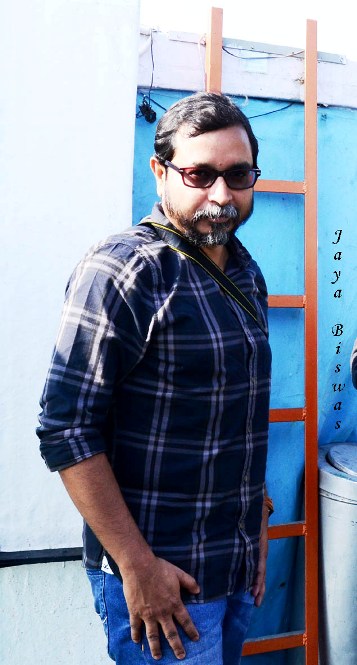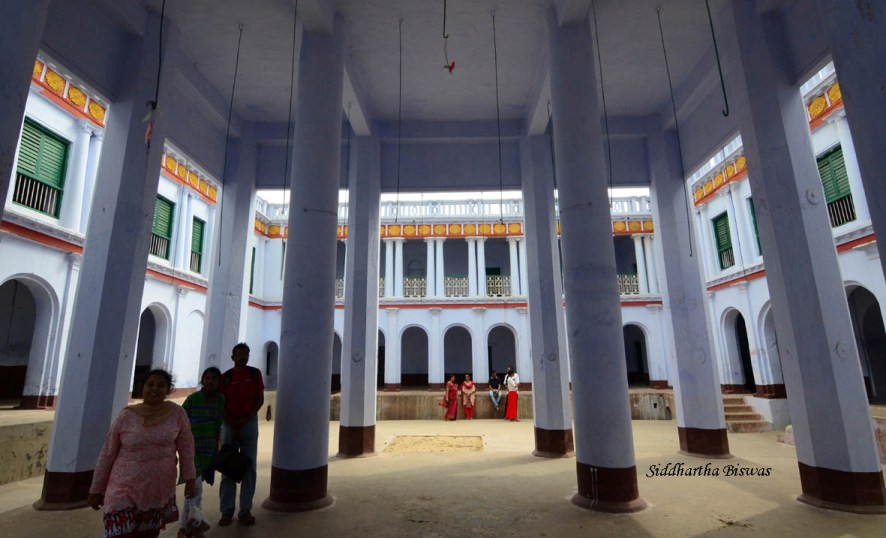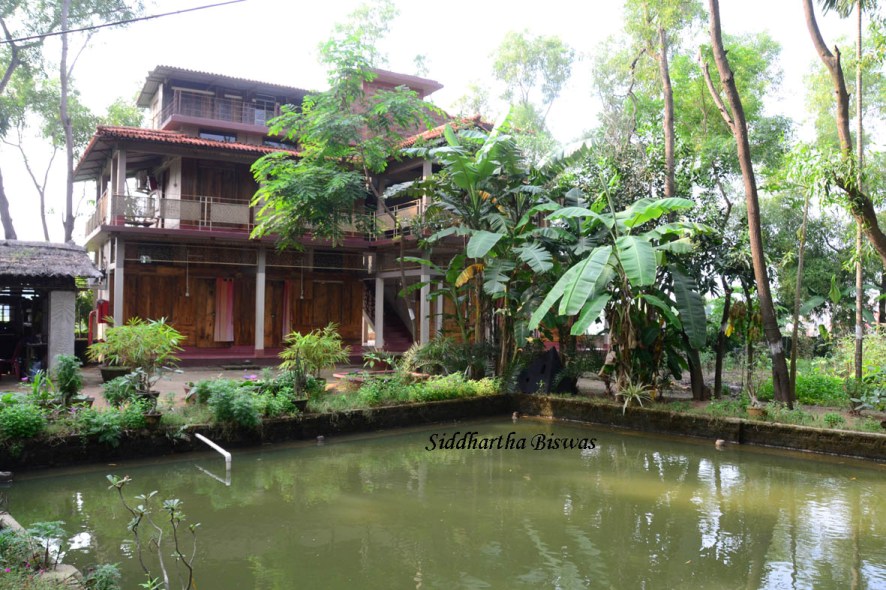Dipankar Roy, Dipankar-da as I call him, is an old friend. He is a man of various interests such as photography, ethnography, music, birds (and bees), old buildings and Shantiniketan.

Shantiniketan is not just a place of interest for him. It is his place of work and it has been his home for almost two decades. So it was quite natural that he would end up writing a book on Shantiniketan.

There are thousands of books on Shantiniketan in thousands of languages. Dipankar-da’s book is special not because it gives you a ‘tourist’s guide’ sort of an exploration, nor is it interested in history proper, but it looks at the idea called Shantiniketan that is now slowly disappearing. Quite thoroughly, Dipankar-da manages to trace the decay: what Shantiniketan was meant to be, and what it is slowly becoming.

Nothing can stop history or cultural progress (you may want to read regress), but Shantiniketan is a notion that is integrally associated with Bengali-ness. And through this exploration Dipankar-da manages to capture the evolution of this core idea. The change that the canonical Bengali culture is going through finds brilliant illustration in this book.
My own memory of Shantiniketan dates to an era which was before colour television became a household reality. I remember a very young me being taken on a train to a place which I had no clue about. It was supposedly quite an important place. But the train we were travelling in behaved inexplicably. When we reached our destination, it off-loaded some passengers, but then decided to move on. Half the people did not manage to get off. It was supposed to stop for a couple of minutes but the driver decided not to let Shantiniketan become too crowded and stopped only for thirty seconds. My mother and my sister were on the platform, my father and myself were moving towards a strange unknown. However, proactive passengers forced the train to stop at the next station, even though it was quite unscheduled. A lot of polite and cultured turmoil followed. I vaguely remember an announcement (no idea what the announcement actually was). Then after an hour or so another train came from the opposite direction and took us to our desired destination. Thankfully, consolatory announcements were made at Bolpur and the marooned half of Biswas family stayed anxious but not without official reassurance.
We stayed in a small house next to a large field. At the end of the field, hugging the horizon, you could see a lovely little station. It was Prantik. Don’t even dream of thinking of the modern Prantik.

There were a few houses dotting the large tepantar-like field. There were trees everywhere. It was a place of general emptiness and peace. Even Shantiniketan was not as crowded. This was the time of Poush Mela – which I vaguely recall as a gentle affair. This winter carnival had not adopted the idea of the carnivalesque to the full yet. This was the late 70s or the very young 80s, so the media-generated craze was still in distant future. Of course, those days are quite gone. As are those ecstatic emptinesses.
I would not find myself in Shantiniketan for a very long period of time. In January of 1996 we, Sujash-da and I would represent our university in a Students’ Seminar organized by Visva-Bharati University. The Seminar would be quite an excellent experience, and I would end up making a few friends who are still very good friends.

January in Shantiniketan is quite something. I remember waking up at six o’clock in the morning because of the cold. I was wearing a pull-over, jeans and was wrapped in a blanket, still it was far too cold to sleep. This was the dormitory of the old Purba Pally Guest House. I still remember with fondness the Tea-man who saved our lives that morning.
My one and only experience of the famous Basanta Utsab followed. The festivities by themselves were as expected.



But I understood why this was such a special celebration. Shantiniketan in March is just brilliant. It is neither too hot nor too cold. There is a warm and strangely comforting wind that blows at dusk. And if you are walking around in the wooded lanes of the University Campus, or the Ashram, or Purba Pally, or towards Sonajhuri, you will know why this place was once chosen as Shantiniketan – the abode of peace.
But even then we could sense that all was not well. The crowds that gathered from all around the state, and neighbouring states, were not entirely culturally motivated. Intentions were not always honourable. And there were already a number of unholy incidents all around. It was no longer the happy and carefree celebration of colours. The seven vices were asserting themselves with a vengeance. Peace is something humanity cannot stand.
We visited Shantiniketan again after a decade. We stayed in a resort called Babli. This ‘we’ is different though. (The following photograph is from Digha, Babli does not have all that sand!)

It was a lovely resort in a then-non-crowded Daranda. This was a farm-house turned into a tourist place. We loved the place even though we saw a lot of snakes. On that trip we got to see the empty slot where Rabindranath Tagore’s Nobel Prize used to be kept.

But we stayed mostly around Lakshmi Shayar – the brilliant lake which is now encircled by resorts (as I hear).

This was one trip where no camera accompanied me! Babli is walking distance from Banalakshmi – where people go to have lunch these days. And we did too; another decade later. This was a day trip with my in-laws. Food and high speed drives dominated this one.

In the very next year we went back. This time the focus was Sonajhuri.

Sonajhuri used to be a local weekend market with a few tribal people selling their ethnic wares. But as it caught the touristy imagination, this became a ‘happening’ place drawing large crowds. So on weekends what you find is a proper fair with a lot of stuff – both of the rustic and decadently ‘designer’ kinds.


There are traffic snarls, totos, lost and found objects and people, photographers, food enthusiasts and everything that is destructive for the fragile Khoai.

There is not much Khoai left in the region. And as progress is progressing, with four lane highways and rapid growth of resorts all around this place, there would be nothing much left. Of course, the commercial Bauls will be there.

And there will always be pseudo-Bauls.

But the excitement that we once felt as the train crossed the Ajay is gone.

Now Shantiniketan is a ‘tourist’ place. People hardly remember what Tagore wanted. The Glass Temple is surrounded by people who speak only of a recent Bengali movie, and have no idea of its actual significance.

Now a trip to Shantiniketan is more about photo sessions and visits to the nearby Rajbaris. And that too because those Rajbaris are famous shooting spots, no one cares about their history. These houses are quite magnificent, but they are mostly visited for fashion, rather than a genuine interest.


Our confirmed address in Shantiniketan now is Sonajhuri Atithi Nibas. It is still peaceful and holds on to the artistic heritage that once was the norm.

Most other resorts have now become places where you go for a weekend binge. I have nothing against weekend binges, but there are a host of places on this planet where you can binge to your heart’s content – why not leave Shantiniketan alone? Or is high-culture so much of a threat, that like everything remotely intellectual, we have to destroy even its last remnants?

Awesome photos-thanks for sharing!
LikeLike
Thank you so much.
LikeLiked by 1 person
Very sad to hear that the Shantiniketan of the olden days is no more. I used to be a regular visitor every basanta utsab and poush mela. I used to stay close to Prantik but somehow, everyone I speak to seems to say a big NO to Prantik. Nevertheless, I enjoyed your article as it reminded me of the many reasons why I kept going back to Shatiniketan. Thank you for sharing.
LikeLiked by 1 person
This is it! Sir, you just spoke my mind. I have been visiting shantiniketan since I was a child. I remember my parents taking me there each year and I have seen the place change like anything for the worst. As a child I felt the same excitement as the train passed Ajay. This time I could hardly understand when it passed. Rampant commercialisation has made shantiniketan a shopping centre and a place for tourists who would like to flaunt the idea of visiting shantiniketan as it is ethnically fashionable for Bengalis. I refrained myself from visiting Kopai this time as the sight of the huge trees being hacked down hurt me so much 3 years back.
LikeLiked by 1 person